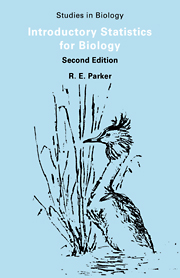Book contents
- Frontmatter
- Contents
- How to use this book
- 1 Probability and Statistics
- 2 Continuous Distributions: Confidence Limits
- 3 Continuous Distributions: Tests of Significance
- 4 Discontinuous Distributions: Binomial Distribution
- 5 Discontinuous Distributions: Poisson Distribution
- 6 Analysis of Frequencies: Single Classification
- 7 Analysis of Frequencies: Double Classification
- 8 Interrelationships of Quantitative Variables
- 9 Analysis of Variance: Single Classification
- 10 Analysis of Variance:Double Classification
- Solutions to Problems
- Further Reading
- Selected Statistical Tables
10 - Analysis of Variance:Double Classification
Published online by Cambridge University Press: 05 June 2012
- Frontmatter
- Contents
- How to use this book
- 1 Probability and Statistics
- 2 Continuous Distributions: Confidence Limits
- 3 Continuous Distributions: Tests of Significance
- 4 Discontinuous Distributions: Binomial Distribution
- 5 Discontinuous Distributions: Poisson Distribution
- 6 Analysis of Frequencies: Single Classification
- 7 Analysis of Frequencies: Double Classification
- 8 Interrelationships of Quantitative Variables
- 9 Analysis of Variance: Single Classification
- 10 Analysis of Variance:Double Classification
- Solutions to Problems
- Further Reading
- Selected Statistical Tables
Summary
Randomized-block design
We have considered briefly the essentials of experimental design and noted, on the one hand, the desirability of treating uniform experimental material under closely-controlled experimental conditions, and on the other hand, the need to employ adequate replication (§ 9.5). In practice these two aspects of experimental design are often found to conflict. With the scale of an investigation fixed by the number of treatments and the amount of replication needed to provide the required sensitivity it is often necessary to tolerate one or more forms of unwanted variation in experimental material, experimental conditions, timing, or even in the identity of the recorder. This kind of difficulty may often be overcome by the use of the randomized-block design. In this we define a number of ‘blocks’* each of which includes at least one replicate for every treatment. We then concentrate our resources on establishing and maintaining uniformity within blocks. Uncontrolled variation between blocks is relatively unimportant because in the numerical analysis the resulting variation can be distinguished from both variation due to treatments and the error variation.
In biology there are many sources of variation which can be dealt with in this way, sources of variation which can be anticipated but not eliminated. Variation in experimental material can often be largely removed from error by forming blocks of organisms of similar age, size, genetic constitution or environmental history (cf. paired sample test, §3.5).
- Type
- Chapter
- Information
- Introductory Statistics for Biology , pp. 80 - 89Publisher: Cambridge University PressPrint publication year: 1991



